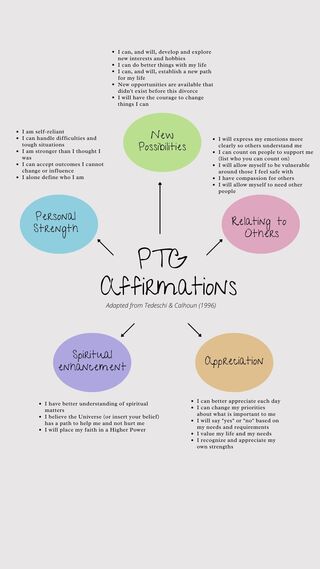Emotional Abuse
Finding a Path to Growth After Emotional Abuse
Affirmations that promote elements of post-traumatic growth could aid healing.
Posted August 9, 2022 Reviewed by Devon Frye
Key points
- Divorce and breakups may be among the most stressful events of a person's life.
- This is especially likely in cases of emotional abuse, which can be hard to articulate or prove to others.
- The theory of post-traumatic growth focuses on thriving after a trauma.
- Creating and repeating personal affirmations could help in the healing process.
The theory of post-traumatic growth, or PTG, focuses on constructs of rebuilding, accepting a situation, promoting resilience and new strengths, and recognizing that change can be positive. Some changes in self-perception, relationships, and philosophy are made in response to a traumatic event. These three broad categories encompass five factors of growth: relating to others; new possibilities; personal strength; spiritual change; and appreciation of life.
Studies have shown that individuals can experience growth from the struggle brought about by highly challenging life circumstances. Post-traumatic growth recognizes that transcending, or overcoming, the adverse initial environment is both a process and an outcome. Suffering from trauma is a catalyst that pushes people to find new meaning in their lives and is part of a much bigger experience than just pain.

Ending a Relationship May Feel Traumatic
Divorce ranks as the second most stressful life event out of 43, according to Holmes and Rahe’s (1967) Life Stress Inventory. For perspective, other stressful situations that ranked lower than divorce included imprisonment (#4), getting fired (#8), foreclosure (#21), and beginning or ending school (#27).
When you think about it, divorce and separation have the potential to wreak havoc in multiple ways: financially, emotionally, physically, and spiritually. High conflict divorces, which may be more likely to occur when one or both partners is high in narcissism, are linked to poor mental and physical health. Divorce has long been associated with reduced resources, damaged self-esteem, emotional trauma, and overwhelming feelings of failure, shame, and guilt. Divorce can also lead to reports of stress, anxiety, depression, social isolation, hospitalization, suicide rates, and substance abuse.
Recovering After Emotional Abuse
Although emotional abuse can be hard to prove in a court of law, it still qualifies as damaging and may even be traumatic. University of Sussex researcher Gemma North (2019) refers to it as "bruises on the soul."
Further, it is complicated to try and define emotional abuse or emotional neglect as it is a multifaceted phenomenon and may be more complex than physical abuse (North, 2019). Indeed, North argues that the terminology is inaccurate and "does not reflect the nuances of harmful relationships" (2019).
In regard to current laws and policies, the responsibility often falls on social workers and local authorities to determine if there is reasonable cause to suspect emotional suffering or significant harm (North, 2019). Overall, emotional abuse and emotional harm are incredibly difficult to prove, let alone hold someone responsible for. The trouble with defining thresholds for this type of abuse has contributed to "complications of getting negative consequences of emotional abuse recognized" (North, 2019). What constitutes significant is not determined by law.

Identifying Your PTG
Oftentimes, then, healing from emotional abuse falls under the control of no one but the victim. Counselors, therapists, social workers, and trusted friends can all assist in guiding one towards healing and supporting the journey, but ultimately the responsibility falls on oneself.
What might this look like? Tedeschi and Calhoun (1996) created the Post-Traumatic Growth Inventory Scale (PTGI) to identify where people experienced the greatest improvements in their life following trauma. The PTGI Scale includes five areas of growth and improvement:
- New possibilities
- Relating to others
- Personal strength
- Spiritual enhancement
- Appreciation
The PTGI measured what people experienced when they looked back and saw how they grew after a trauma. But the affirmations below could serve to guide you to a healthier future. Choose your favorite affirmations from the chart shown to remind yourself what you are capable of achieving.

Personal Strength
- I am self-reliant.
- I can handle difficulties and tough situations.
- I am stronger than I thought I was.
- I can accept outcomes I cannot change or influence.
- I alone define who I am.
New Possibilities
- I can, and will, develop and explore new interests and hobbies.
- I can do better things with my life.
- I can, and will, establish a new path for my life.
- New opportunities are available that didn't exist before this relationship ended.
- I will have the courage to change things I can.
Relating to Others
- I will express my emotions more clearly so others understand me.
- I can count on people to support me (list who you can count on).
- I will allow myself to be vulnerable around those I feel safe with.
- I have compassion for others.
- I will allow myself to need other people.
Appreciation
- I can better appreciate each day.
- I can change my priorities about what is important to me.
- I will say "yes" or "no" based on my needs and requirements.
- I value my life and my needs.
- I recognize and appreciate my own strengths.
Spiritual Enhancement
- I have a better understanding of spiritual matters.
- I believe the universe (or insert your belief) has a path to help me and not hurt me.
- I will place my faith in a higher power (if relevant to your life).
References
American Institute of Stress. (2022). stress.org/holmes-rahe-stress-inventory
Elizabeth Kubler-Ross Foundation. www.ekrfoundation.org
Tedeschi, R. G., & Calhoun, L. G. (1996). The posttraumatic growth inventory: Measuring the positive legacy of trauma. Journal of Traumatic Stress, 9(3), 455-471. https://10.1002/jts.2490090305
Tedeschi, R. G., Cann, A., Taku, K., Senol-Durak, E., & Calhoun, L. G. (2017). The posttraumatic growth inventory: A revision integrating existential and spiritual change. Journal of Traumatic Stress, 30(1), 11-18. https://10.1002/jts.22155
Gemma North (2019) Assessing for bruises on the soul: identifying and evidencing childhood emotional abuse, Journal of Social Welfare and Family Law, 41:3, 302-320, DOI: 10.1080/09649069.2019.1627086
Hochenberger, K. L. D. (2022). Healing unhappy endings: Divorce and separations. Kindle Direct Publishing. Contact excelsiorlifecoach@gmail.com




